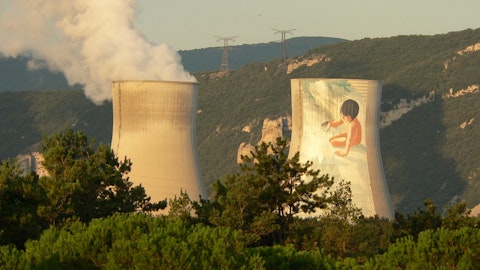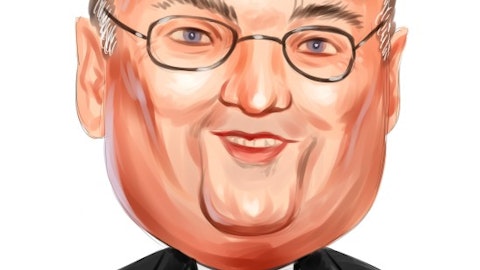Gerardo Norcia: Sure. So Jeremy, I’ll just start by saying, look, we like those assets, they’ve created extraordinary returns for us and great cash flows and we still see a strong pipeline of growth. And as we — we’re in the market all the time talking about value. And I can tell you that at this point in time, based on our long-term plan for value creation, we don’t see the opportunity to create incremental value above what we could expect now the assets are extremely accretive but we always look to create incremental value over our long-term plan. And we don’t see that opportunity just yet. But if it presents itself, we will exercise that opportunity, I assure you. And again, we’re in conversations all the time with the market. There’s obviously lots of dialogue that happens in this type of marketplace.
Jeremy Tonet: Got it. That’s very helpful there. And then I just want to come back and kind of on the back of some of your earlier comments here, talking about the renewable energy plan. Just wondering if you might be able to peel back a little bit more of the details here, what we should be expecting, what you’re focused on for the upcoming renewable energy plan?
Gerardo Norcia: Well, what I would say that is our voluntary plan continues. I’ll just replay this that we have one of the largest voluntary renewable development plans in the country based on the size of our company and that continues to exceed our expectations. We currently have about 2,400 megawatts signed and a 2,500 megawatt goal for the next 5 years. So you can see that we’re getting very close to having to update that plan. So I would say that’s one update that we will provide as we roll forward the next 5-year plan. In addition to that, if the IRP becomes more aggressive as we move forward beyond the current 5-year plan, so I think we’ll see some tailwinds from that in the plan as well as we roll it together. So those are the opportunities that we see longer term and near term in renewable energy development plan.
Operator: Next question comes from the line of David Arcaro with Morgan Stanley.
David Arcaro: One more Vantage question here. I was curious, are data centers or customer class that you go after? I’m thinking with custom energy solutions. Just wondering if there’s any emerging growth opportunities there.
Gerardo Norcia: So the short answer is yes but maybe I’ll describe this in sort of more global perspective for DTE. I would say both our utility, electric utility and Vantage are well positioned to pursue these opportunities with data centers here just right here in our backyard and also with Vantage beyond our backyard. But in Michigan, let me focus on Michigan for a minute. We have great access to water, favorable climate conditions and power plant sites with large land positions and grid access that I think will be very attractive and is very attractive to the centers [ph] that we are having conversations with — we’re seeing significant interest and we’re engaged in discussions. And I will say this much changes on the legislation that exempts the sales and use tax.
And as you know, you may recall that the house here in Michigan proved the bills in a bipartisan way, they’re awaiting approval by the Senate. And the governor has indicated a great willingness to sign those bills if they come to her desk. So I believe that we’re well positioned in Michigan with both the electric utility and Vantage that could provide on-site energy services. So we’re — we’re having those conversations, they’re early but the opportunity is sizable.
David Arcaro: Great. That’s helpful color. Then I was wondering if — let’s see, pivoting to the rate case — the electric rate case. I was wondering if you could maybe help contextualize some of the Attorney General’s comments that were out there on the size of the request. And maybe any early indications or early thoughts on whether you think a settlement could be something that you go after and could be acceptable in this rate case?
Joi Harris: Yes. I think the Attorney General, pretty much is on par, things that we expected. We are really — this rate case, as you know, is really all about our capital. And the capital we’re deploying is targeting the distribution infrastructure and we’re looking to improve reliability and certainly continue our journey to transition to cleaner energy sources faster to the state. And with respect to the distribution infrastructure, we’re looking to reduce power outages by 30% and cut our outage time in half over the next 5 years. So the case is going as we had planned, we just filed it. We do know the prehearing is scheduled for tomorrow and we’ll start to know this and understand the schedule and then start to get feedback from the interveners and from the staff.
So I guess what’s in the case, in general, aside from the investment that we have in our infrastructure, there’s also a storm tracker. The storm tracker is about $65 million. It’s based on the 5-year average. And it’s a 2-way tracker with a 50-50 sharing of anything above and below rates. So that’s really what’s in the case, investments that we have in our infrastructure to drive reliability improvement and certainly cleaner generation. You know that the revenue requirement is about $456 million and we’re targeting an ROE of 10.5% with a 50-50 cap structure.
Gerardo Norcia: In terms of prospects for settlement, David, we’ve got a lot of interveners in this case and we will do all we can to settle. But again, as Joi said, since this case is really primarily about capital deployment and well understood and well known agendas for capital deployment. We’re confident that even if it goes to its full course in terms of litigation that we will get supportive outcome. I think the commission has a strong track record in that way and also the administration supports these investments and knows that they’re extremely important for the state to pursue economic development and also provide more value to our customers and our citizens here in the state of Michigan. So we’re feeling pretty good about how it’s progressing.
Operator: The next question comes from the line of Durgesh Chopra with Evercore ISI.
Durgesh Chopra: Jerry, Joi, just on the discussion on the electric rate case settlement. You guys have discussed or in the past have talked about potentially a partial settlement with some parties and not unanimously. Is that something that you could pursue with this electric rate case?
Gerardo Norcia: We could, Durgesh. And certainly, we will. Again, I don’t want to hinge too many hopes on a settlement. We will do all we can to settle. I think — but as we saw in our last rate case, we weren’t able to bring all the parties together for various reasons and sometimes that happens. But our opening position and our desire is to settle but we’re also confident that we will get supportive outcomes in the event that there is not a settlement.





